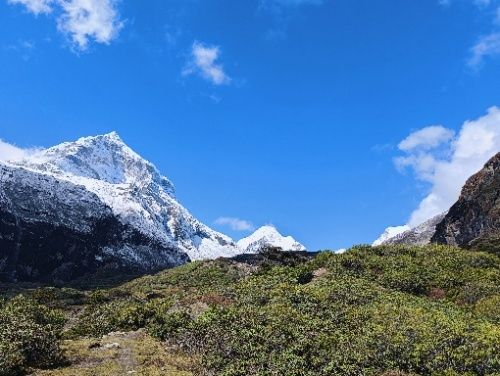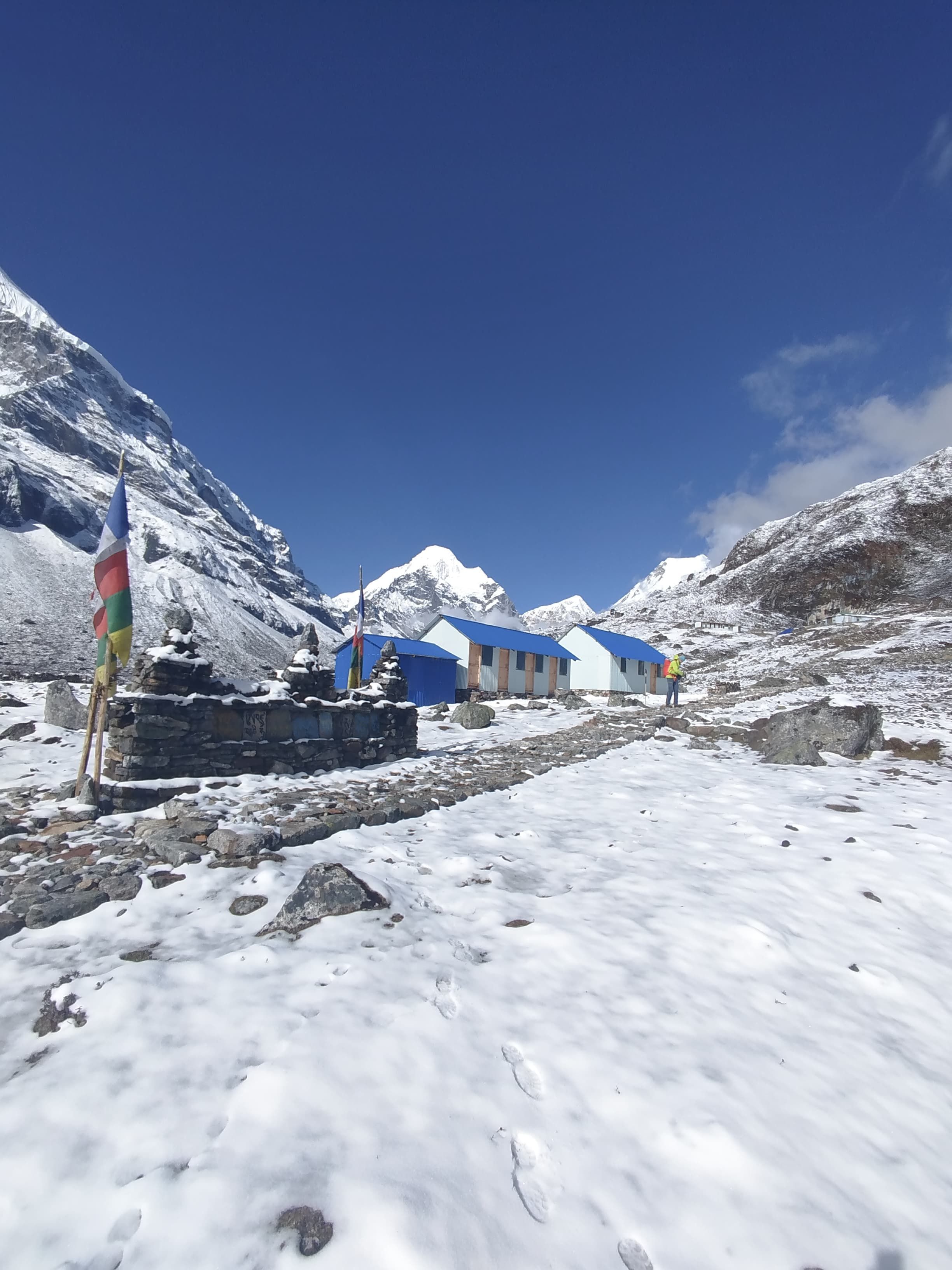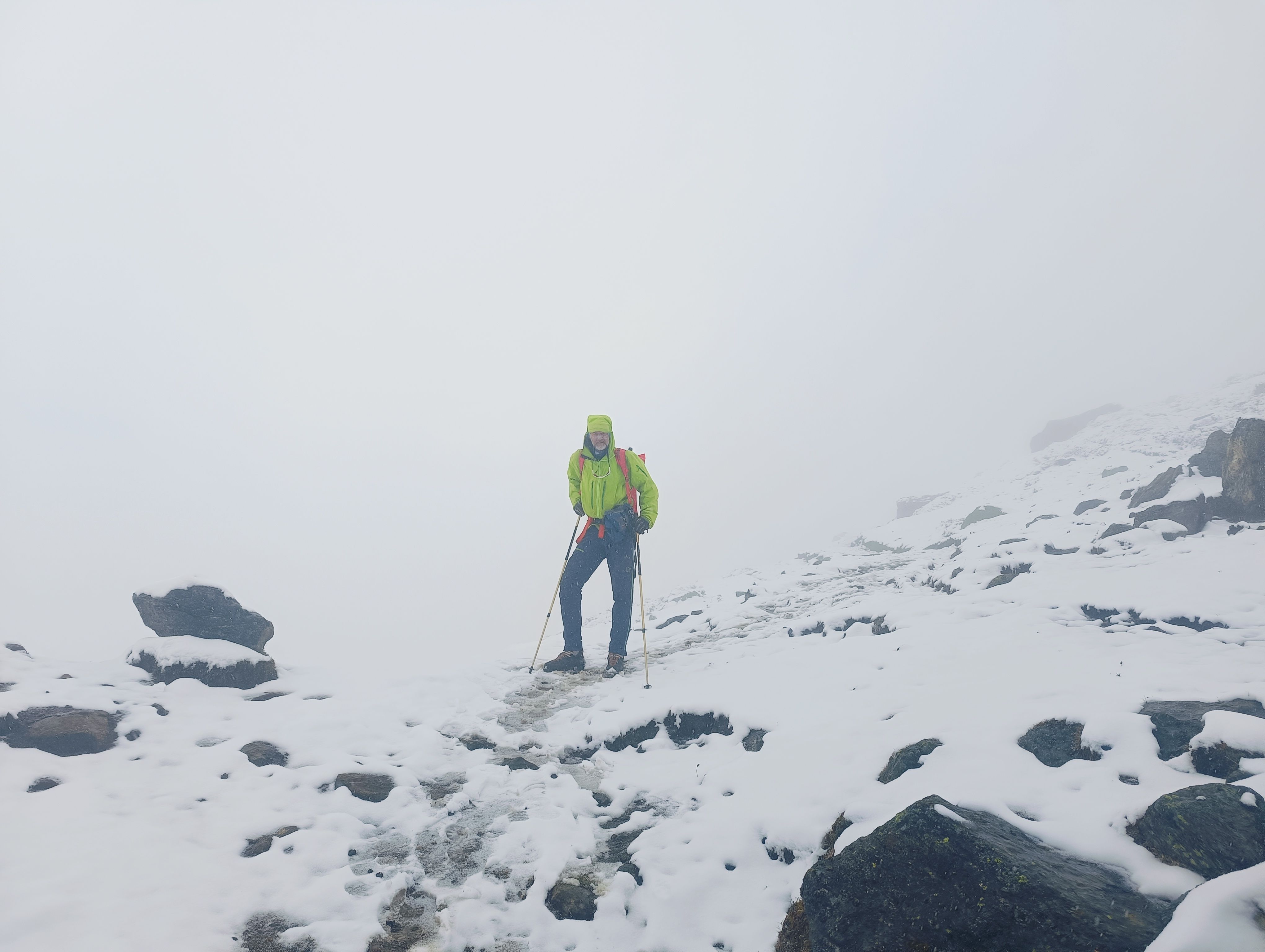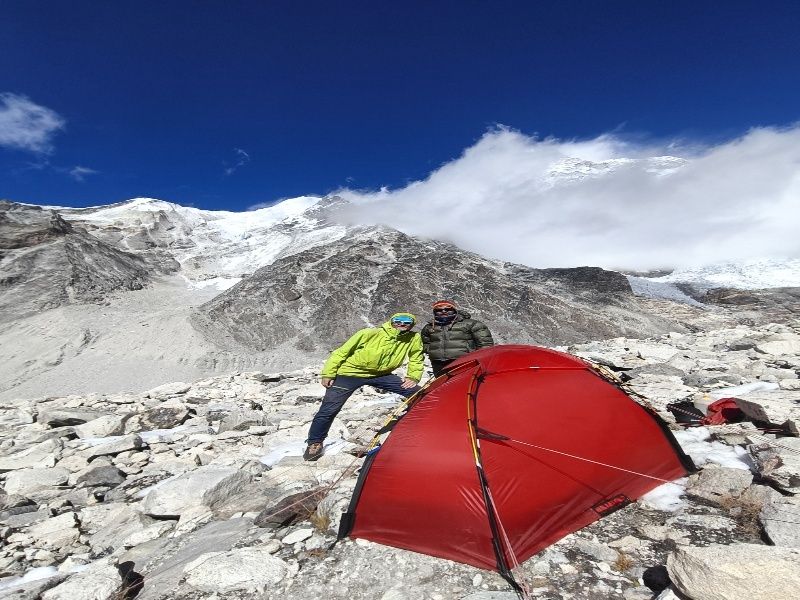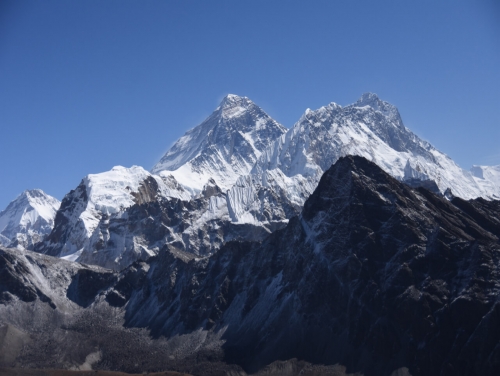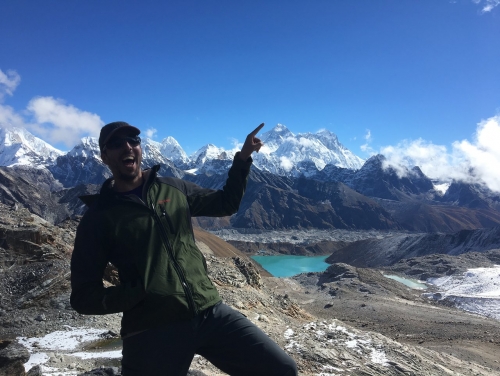Accommodation during Makalu Base Camp Trek
There are limited and basic accommodation options during the Makalu Base Camp Trek. In Kathmandu, you will be lodged in typical hotels with comfortable beds, private bathrooms and Wi-Fi. These hotels are clean and provide good meals.
In the journey, the lodging is based on most teahouses or lodges. Teahouses provide basic rooms containing twin beds, a mattress, a sheet and a pillow. Most rooms are small and have shared bathrooms. Hot showers are available at some teahouses but may cost extra.
In higher altitudes, facilities become more basic. Blankets can be light, and therefore, it really matters to have a warm sleeping bag with you. Toilets are often squat-style and outside the lodge.
Teahouses serve meals in a communal dining area. The food includes rice, lentils, noodles, soups, and tea. Vegetarian options are common.
Limited or no accommodation may be available in remote areas. Camping could become necessary, with tents and equipment carried by porters.
Expect simple living conditions but warm hospitality throughout the trek.
Makalu Base Camp Trek Food
Food at Makalu Base Camp Trek is simple but nutritious. Meals are served in teahouses along the trail.
Breakfast options include bread, eggs, pancakes, porridge, and tea. Lunch is usually rice, lentils, noodles, or fried rice. Dinner includes similar items like dal bhat, pasta, soups, and potatoes.
Vegetarian meals are common and freshly prepared. Meat can be obtained at lower altitudes, but it is not highly suggested owing to storage issues. Snackable biscuits, chocolate, and energy bars can be purchased at some stops.
Drinks like tea, coffee, and hot water are available. Water can be bought in bottles, but it is more advisable to have a reusable bottle and water purification tablets. Food is easy, nourishing and keeps your energy going.
How difficult is Makalu Base Camp Trek?
The Makalu Base Camp Trek is hard and levels up to experienced trekkers. The trail is remote, long, and physically demanding.
Daily walking lengths vary from 5 to 8 hours on steep, rocky and rough terrain. The trek involves high altitudes, reaching over 5,000 meters. Acclimatization days are provided, but altitude sickness may occur.
It demands tolerance and perseverance to cross high passes, e.g., Shipton La. Weather conditions can change suddenly, especially at higher altitudes. Rain, snow, and cold temperatures add to the challenge.
In remote locations, while food and accommodation are simple, facilities are also limited. It is also of great importance to take with you good equipment and plan for camping in some sections.
Trekkers must be physically fit and mentally prepared. Prior experience in multi-day high-altitude trekking is recommended. Cardiovascular and endurance training can help you prepare.
The trek is remote, with limited access to medical help or rescue services. You are required to have a first aid kit and be aware of health and hydration.
This hike is difficult, but the reward is immense, providing breathtaking scenery and a feeling of achievement. With proper preparation and appropriate instruction, the problems are surmountable.
Challenging and Safety Tips
The Makalu Base Camp Trek is tough and remote. The trails are steep, rocky, and physically demanding. High altitude and unpredictable weather make it harder.
To stay safe, prepare well before the trek. Build your stamina with regular exercise and cardio workouts. Pack appropriate trekking equipment, such as warm clothing and weather resistant boots and a quality sleeping bag.
Take altitude sickness seriously. Acclimatize properly, ascend slowly and stay hydrated. Be aware of the symptoms of altitude sickness and inform your guide if you start to feel unwell.
Pack a first aid kit with essentials like painkillers, bandages, and altitude sickness medication. Use water purification tablets for safe drinking water.
Get a trained guide and a porter for safety and guidance. Follow their advice during challenging sections and river crossings.
Be cautious with food and hygiene to avoid illness. Never check the weather forecast, and do not go hiking in adverse weather.
Makalu Base Camp Trek Extension and Alternatives
However, if you have spare time and a wanting for more adventure, there are some trek extensions and options within reach of the Makalu Base Camp Trek.
An example of this is the Barun Valley Trek, which leads you further into the Makalu Barun National Park. On this walk, one gets incredible views of snow-clad mountains and wild areas. It also provides a chance to explore untouched wilderness.
You may also opt for the Kanchenjunga Base Camp Trek, situated in the nearby Kanchanjunga area. In this trek, you will reach the foot of the world's third-highest mountain, Mount Kanchenjunga.
The trail is similar in its difficulty to the Makalu trek, but it provides different sceneries and cultural experiences.
An alternative is the Everest Base Camp Trek, by crossing Sherpani col the highest pass in the region,which is more widely used and accessible. Although more hectic, it still allows one to witness scenic vistas of the Himalayan ranges, such as Mount Everest. The way is very well-paved, and teahouses and facilities are abundant.
These extensions and alternatives provide various options depending on your interests and available time. They are all attractive and distinct in various degrees of difficulty and challenge, with each one offering different levels of experience.
Permits for Makalu Base Camp Trek
For trekking in the Makalu area, there are three main permits required:
Makalu Barun National Park and Conservation Area Permit
Entry to Makalu Barun National Park is needed by this permit. The expense is around USD 30 per person for foreigners.
Makalu Rural Municipality Permit
This permit is necessary for entering the rural municipality area. The cost is around USD 20 per person.
Restricted Area Special Permit
This permit may be required if your route passes through restricted villages like Chepuwa, Hatiya, Kimathangka, and Pawakhola.
The permit is roughly USD 10 per person per week for the initial 4 weeks. Subsequently, the price rises to USD 20 per person per week.
These permits are crucial to guarantee safe and legal walking in the area. Make sure to apply for them before your trek and carry them at all times.
Travel Insurance
Travel insurance is necessary for Makalu Base Camp Trek. It covers emergencies like medical problems, accidents, or evacuation. All this trekking is at altitude, so you should be covered for altitude disease and its management.
Insurance is needed to cover trip cancellations, luggage loss, and delays, too. Look for a plan that includes emergency evacuation by helicopter or a rescue team, as the area is remote.
The policy shall be applicable to high-altitude trekking above 3,000 m. Before leaving, carry a copy of your insurance and share details with your guide. With travel insurance, trekking doesn't have to cause anxiety.
Best seasons for Makalu Base Camp Trek
The most ideal seasons for Makalu Base Camp Trekking are spring (March to May) and autumn (September to November).
The months have been over, and the weather has been dry and clear, hence clear and dry weather has allowed us to observe Himalayan ranges from an enormously far distance.
Spring offers warm weather, and flowers run alongside the trail. Autumn offers stable weather and colourful landscapes.
Summer (June to August) is the monsoon season, with heavy rainfall that can make trails slippery and difficult. Winter (December to February) is extremely cold, particularly at great heights, and it may snow.
To enjoy the full benefit, walk in spring or autumn when the Makalu weather is better, and the trekking conditions are optimal.
Makalu Base Camp Weather
The weather at Makalu Base Camp route is very capricious. The hike offers a range of elevations, and therefore, temperatures will fluctuate.
During spring (March to May), temperatures are generally mild. Lower altitudes can see temperatures between 15°C and 20°C during the day, while nights can get chilly, dropping to around 5°C.
Higher elevations are significantly colder, particularly during the early morning and late evening hours.
Autumn (September to November) is the best time for the trek. The weather is dry and stable. Daytime temperatures are still mild (comparable with spring), but cooling down as one goes higher. The clear skies offer great views of the mountains.
In summer (June to August), the monsoon brings heavy rain. This renders the trail smooth and may result in being unable to access certain sections of the path.
Winter (December to February) is extremely cold, and even more so at high altitudes, with temperatures falling below freezing. Snowfall is common, making trekking difficult.
Spring and autumn are the best weather to go trekking.
Fitness and Acclimatization
To finish the Makalu Base Camp Trek, one must have good fitness. The trek is long and involves steep climbs. Regular cardio (e.g., walking, running, cycling) will be beneficial. Strength training of the legs, core, and upper body is also useful.
Get accustomed to walking at high elevations before high-altitude travel. Training in the mountains (if it is possible) can acclimatise you.
Acclimatization is key to avoiding altitude sickness. The trek has rest days to allow your body to adapt to thin air. Whilst at altitude over these days, stay up high and sleep low so that your body can acclimatize in the meantime.
Drink plenty of water, eat well, and avoid alcohol. If you feel unwell, inform your guide immediately.
Good fitness and sound acclimatization will enable you to take the walk safely and successfully.
Makalu Base Camp Trek Cost
The Himalayan Odyssey provides the Makalu Base Camp Trek Cost for USD 1,750. For all the services required with a corresponding and inclusive to permits, boarding, which comprises the trip, is included in this price.
The cost of Makalu Base Camp Trek varies to some extent depending on the length of the walk, the cost of the permits, the costs for the food and the costs of the nights in hotels. Generally, the trek is priced at about USD 1,450 and USD 22,00 per person.
This includes but is not limited to, permits, guide fees, porters, accommodation, food and drink and transport. It may be more expensive if you want options such as a private guide or if you hike in tourist season.
To ensure a pleasant and trouble-free experience, it is recommended to select a reputable trekking partner such as The Himalayan Odyssey. This ensures you’re fully prepared and have everything included in the package.
Group size for Makalu Base Camp Trek
The optimal size of the group for the Makalu Base Camp Trek is between 2 and 12 people. Smaller groups facilitate a more individualized and more interactive experience with the guide in terms of interaction with the guide.
With larger groups, the trek could be construed as more communal, but coordinating logistics and ensuring everyone stays on schedule can be a challenge.
A group size of 6 to 8 people is often considered perfect for balancing both individual attention and group dynamics.
Despite variations, whether small or large, it is a must to have an experienced guide and porters to guarantee safety and an easy journey along the way.
Environmental Impacts and Reasonable Trek
The Makalu Base Camp Trek traverses a sensitive ecosystem. Because the area has some unusual wildlife and plant species, one must exercise extreme care.
Trash and waste are a big concern. Never leave litter on the trail, and never pack out trash. Use biodegradable products to minimize environmental impact.
Remain on marked trails to avoid disturbance to vegetation and wildlife. Be respectful of local communities and their customs.
Conserving water using treated water and limiting the use of natural resources is very vital.
For a safe and sustainable hike, select a reputed trekking agency that practices eco-tourism. The goal is to enjoy the trek while leaving minimal impact on the environment for future generations.
Customized Itinerary for Makalu Base Camp Trek
A customized itinerary can make your Makalu Base Camp Trek experience even better. Because everyone has different preferences and requirements, The Himalayan Odyssey does.
We can tailor the trek to match your schedule, pace, and interests. From more extended time in base camp to additional acclimatization days or even to venture into the surrounding areas, they can tailor the itinerary.
If you are looking for a relaxed walk or a fast walk, The Himalayan Odyssey can provide you with both. You can also decide to take additional rest days or reduce the daily trekking hours to have a comfortable travel.
Personalizing your itinerary will result in you enjoying your trek the best. The team at The Himalayan Odyssey will collaborate with you to engineer the best plan that is right for your requirements and will help you have a wonderful trekking experience.
Is a solo trek possible in Makalu Base Camp Trek?
It's feasible to make a solo trip through the Makalu Base Camp area, but not advisable for most hikers. The way is off the beaten track, and the ground is sometimes difficult.
With a guide and porter, it's safer and more pleasant to trek. The travel guide has a roadmap, manages the permits and guarantees support. They can also assist in case of an emergency.
Solo trekkers must obtain the necessary permits and be prepared for the trek’s physical and mental demands.
If you’re experienced and prepared, a solo trek can be done. However, having a guide ensures your safety and provides a better trekking experience.
Makalu Base Camp Trek Map
Navigation of the Makalu Base Camp Trek depends on a map. It provides you with knowledge about the way it can be used for monitoring the progress and it can prevent getting lost in the wilderness.
Using a map means you will always follow the right way, especially in difficult terrain. The following is a map of the trek with the accompanying reference picture.
Makalu Base Camp Trek Distance
The total distance of the Makalu Base Camp Trek is approximately 160 to 180 kilometres, depending on the exact route.
The route begins in Tumlingtar and traverses several villages and landscapes up to Makalu Base Camp.
Each day’s trek covers about 8 to 15 kilometers. There will be variations in the distance depending on your speed and ground.
The trek can take around 15 to 17 days to complete, with several rest and acclimatization days.
The total walking length is reachable for most trekkers, providing the right preparation and physical fitness. Just be deliberate and savour the experience.
Booking and Payment Conditions
For Makalu Base Camp Trek bookings, please contact The Himalayan Odyssey. A deposit is required to secure your spot.
The deposit is typically 20-30% of the total trip price. The remaining balance is paid before or upon arrival.
Payments are available via bank transfer, credit card, and other methods.
For cancellations, The Himalayan Odyssey has specific terms. If you cancel early, you will possibly receive a partial refund.
Read the terms and conditions before booking. This allows the payment process and cancellation policies to be understood.
Please always double check your booking and payment information with The Himalayan Odyssey to make sure all is in order before your trek.
Important Note about the Fixed Departure
Fixed departure dates are pre-set dates for group treks. They let you go on a group trek together. These dates are best if you like trekking with a fixed itinerary.
The fixed departures guarantee that the walk will continue even if only a small number of trekkers are participating. Early booking is advisable as places fill up very fast.
Just please make sure the dates of departure and the availability match before confirming the booking with us.
Porter service
The Himalayan Odyssey provides trustworthy porter services that will help to improve the comfort of your trek. A porter will take all your large bags so that you can concentrate on good sightseeing.
Porters are seasoned and know the land, so your pack is hand-carried to each station safely. They are equipped to cope with the physical rigours of the trek and can cope with the difficult terrain.
The presence of a porter also facilitates the limits of the weight, because the load is carried by the porter, and you are carrying only the items necessary in your daypack. This will lessen the load and make you more mobile.
With the Himalayan Odyssey, every porter is taken care of, properly compensated, and works in safe surroundings.
If you’re looking for a more convenient trekking experience, The Himalayan Odyssey can arrange a porter for you.
This service provides the ability to be comfortable on a trek and to appreciate the beauty of Makalu Base Camp Trek without the complication of carrying heavy baggage.
Safe Drinking Water
Safe drinkable water is critical at Makalu Base Camp Trek. The Himalayan Odyssey ensures access to clean water.
At tea houses, filtered or boiled water is available. It’s safer than drinking directly from streams or rivers.
You may also carry water purification tablets or a portable water filter for added security. This will help you to avoid contamination of microorganisms in the water.
Stay hydrated throughout the trek, but always use safe water sources. This will help you prevent stomach problems and to enjoy the walk without worrying.
Altitude Sickness
Altitude sickness can develop if you hike to higher elevations, such as at the Makalu Base Camp. It occurs due to the lower concentration of oxygen as you ascend in altitudes.
Symptoms of altitude sickness are headaches, vertigo, nausea, and tiredness. These symptoms can start at altitudes above 2,500 meters.
To prevent altitude sickness, do not rush, let your body readjust gradually. Acclimatization days are key to acclimatizing to the increased altitude. Drink enough water, do not drink alcohol, and eat healthily to stay healthy.
In case you experience symptoms of altitude sickness, let your guide know as soon as possible. The case of severe conditions requires alternate, lower altitudinal rest when necessary.
It's important to heed your body and be careful. Acclimatization and hydration are important to prevent altitude sickness, allowing you to safely undertake your trek.
Joining Group Makalu Base Camp Trek
Group trek joining is an excellent opportunity to do the Makalu Base Camp Trek.
You’ll meet other trekkers and share the adventure. That traveller's journey is a chance for pleasure and socialising.
A group trek also provides supervision by a knowledgeable leader. The guide ensures everyone stays safe and on track.
It is common for group treks to have defined start times, which allows planning to proceed more readily.
Joining a group can also lead to reducing the cost by which expenses are shared.
If you prefer company during your trek, a group trek is a great option.
First Aid Kit
A first aid kit is also the most important thing for any trek, such as the Makalu Base Camp Trek.
Your kit should contain essentials (e.g., bandages, antiseptic wipes, painkillers, blister therapy).
You should also carry personal medications, including any that you need to keep. It’s a good idea to include altitude sickness medication and a thermometer. Keep the kit small and easy to transport.
Your backpack will also have a guide which includes a first aid kit, but it is always wise to carry your own.
Nepal Visa Information
Most travellers need a visa to enter Nepal. Visas for tourists can be obtained at the Tribhuvan International Airport, Kathmandu. You can also apply online in advance.
Visa fees depend on the length of stay. The fees for a 15-day visa are approximately USD 30, a 30-day visa is USD 50, and a 90-day visa is USD 125.
Make sure your passport is valid for at least six months from your arrival date. You’ll need a passport-size photo when applying for the visa.
Moreover, when considering certain nationalities, other visa conditions may apply, and it is hence preferable to review them prior to departure.
Currency Exchange in Nepal
Nepalese Rupee (NPR) is the official currency of Nepal. Foreign currency can be exchanged at banks, at machines (exchange offices) and at airports.
ATMs are to be found in big cities (e.g.Kathmandu and Pokhara), but not in remote locations (e.g., Makalu Base Camp).
It’s a good idea to carry enough cash for your trek. In the cities, most shops and hotels accept credit or debit cards. On the other hand, cash payments are the most common in rural settings.
It is important to exchange currency prior to travelling into remote areas or withdraw cash beforehand. Don't buy/sell money on the underground market to guarantee just rates and security.
Emergency Preparedness
It is also necessary to be prepared for emergencies while doing the Makalu Base Camp Trek. Always have a fully charged phone, and consider carrying a power bank.
Your guide will have emergency phone numbers and will be familiar with how to summon assistance in an emergency.
Obtain a first aid kit equipped with the necessary items. Learn basic first aid skills before your trek to handle minor injuries.
In case of suffering from altitude sickness/injury, notify your guide at once. Be aware of evacuation procedures in case of serious health issues.
Obtain travel insurance with coverage for medical issues and evacuation. By being prepared, you can ensure a safe and enjoyable trek.

.webp)
